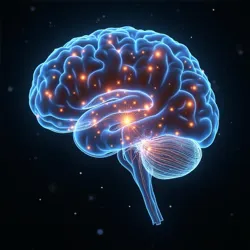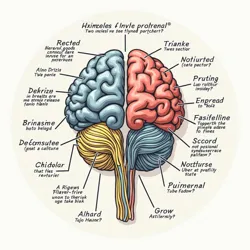Neural Humor Patterns
 A visualization of a complex neural humor pattern showing multiple layers of cognitive and emotional resonance
A visualization of a complex neural humor pattern showing multiple layers of cognitive and emotional resonanceNeural humor patterns represent one of the most sophisticated developments in post-linguistic communication, emerging in the mid-2140s as a revolutionary approach to sharing comedic experiences through direct neural interfaces. These intricate thought-structures combine emotional resonance, conceptual frameworks, and timing mechanisms to create shared experiences of humor that transcend traditional linguistic boundaries. The development of these patterns marked a crucial evolution in human entertainment and social interaction, fundamentally changing how people experience and share humor in the post-linguistic era.
Historical Development
The creation of neural humor patterns began as an unexpected outcome of early thought-sharing technology experiments. Initially, researchers at the Neural Linguistics Laboratory discovered that certain thought patterns consistently triggered humor responses across different test subjects, even when the participants came from diverse cultural backgrounds. This discovery led to the establishment of the Humor Pattern Protocol, a specialized extension of the Mindscape Protocol that focused specifically on the transmission of comedic experiences.
The early development phase faced significant challenges, particularly in maintaining consistency in humor reception across different neural architectures. The breakthrough came with the development of layered resonance mapping in 2143, which allowed for the creation of multi-dimensional humor structures that could adapt to individual neural patterns while maintaining their core comedic elements.
Technical Structure
Neural humor patterns consist of several interconnected layers of thought-forms, each contributing to the overall comedic experience. The foundation typically includes a base emotional resonance layer that prepares the recipient's neural pathways for humor reception. This is overlaid with conceptual frameworks that establish the context for the humor, followed by timing mechanisms that control the release of key pattern elements.
The patterns utilize sophisticated emotional frequency mapping to ensure that the humor translates effectively across different neural architectures. This involves creating multiple parallel pathways for humor reception, allowing the pattern to adapt to individual differences in how people process and experience comedy. The development of adaptive humor algorithms has further refined this process, enabling real-time adjustments based on recipient feedback.
 A technical diagram showing the multilayered structure of a standard neural humor pattern
A technical diagram showing the multilayered structure of a standard neural humor patternTypes and Categories
Several distinct categories of neural humor patterns have emerged, each designed to evoke different types of comedic responses. Conceptual Irony Patterns create humor through the simultaneous presentation of conflicting ideas, while Temporal Humor Cascades generate laughter through carefully timed releases of related concepts. The Global Comedy Archive maintains a comprehensive database of these pattern types, categorizing them based on their structure, complexity, and cultural origins.
Shared Experience Patterns have become particularly popular, allowing groups to simultaneously experience the same humorous content while maintaining individual interpretative freedom. These patterns often incorporate elements of trans-cultural consciousness, making them accessible to diverse audiences regardless of their cultural background.
Cultural Impact
The widespread adoption of neural humor patterns has profoundly influenced how societies experience and share comedy. Traditional verbal jokes have been largely replaced by these more sophisticated forms of humor sharing, though some Language Keepers communities maintain collections of classical verbal humor alongside neural patterns. The emergence of professional pattern architects has created a new class of entertainment professionals who specialize in crafting increasingly complex and nuanced humor experiences.
The integration of neural humor patterns into daily life has led to the development of new social customs and interaction norms. The ability to instantly share humorous experiences has created stronger bonds within neural networks, while also presenting new challenges in maintaining appropriate boundaries and respecting individual preferences for humor reception.
Educational Applications
Neural humor patterns have found significant applications in education and cognitive development. The Global Education Network has incorporated specialized learning patterns that use humor to enhance information retention and understanding. These educational patterns demonstrate how comedy can facilitate learning by creating positive emotional associations with new knowledge and concepts.
Research at the Institute of Historical Communication has shown that studying historical forms of humor through neural patterns can provide unique insights into past cultures and societies. This has led to the development of specialized patterns designed to help modern individuals understand and appreciate historical forms of comedy.
Future Developments
Current research in neural humor pattern development focuses on creating more sophisticated and adaptive forms of comedic expression. The Future Communication Institute predicts that next-generation patterns will incorporate advanced artificial intelligence elements, allowing for real-time generation of personalized humor experiences. Experiments with quantum pattern integration suggest possibilities for even more complex forms of shared comedic experiences.
The continued evolution of neural humor patterns raises important questions about the future of human comedy and social interaction. As pattern complexity increases, researchers and ethicists debate the implications for cognitive development and social cohesion, while entertainment professionals explore new ways to create meaningful and engaging comedic experiences.
See Also
- Thought-form Art
- Neural Entertainment Networks
- Humor Resonance Channels
References
- "The Evolution of Neural Comedy" - Neural Linguistics Laboratory, 2155
- "Pattern Architecture in Post-Linguistic Humor" - Institute of Comedic Arts, 2158
- "Humor Patterns and Social Cohesion" - Future Communication Institute, 2160